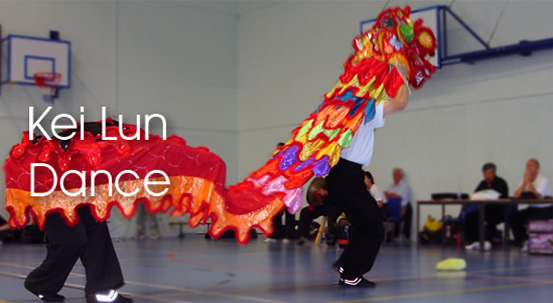Although the Lion Dance is very popular amongst kung fu practitioners traditionally it is the Kei Lun Dance that is performed in our style. This article explains some of the differences between the Lion Dance and the Kei Lun Dance.
Master Yau explains the finer points of the Kai Lun dance.
I'm sure you know about the Lion Dance and the Dragon Dance, both of which are very common at Chinese celebrations like New Year. However, there is another dance called the Kei Lun Dance.

There are 4 Chinese mythical creatures: the Phoenix, the Dragon, the Tortoise and the Kei Lun. Amoungst other things each one of the four represents a position on the compass. The Kei Lun represents the west, the Phoenix the south, the Tortoise the north and the Dragon the east.
When translated into English the Kei Lun is often said to be a unicorn but this is probably not a good translation as the creature is quite different from the horse-like animal with a single horn. Kei Lun is also has a number of different Romanisations such as Chi Lin, Ch'i Lin, Jilin and Ki Lin some of which are probably Romanisations of the Mandarin name for the creature. Here we try to use Romanisation of Cantonese when ever possible and Kei4 Lun4 (complete with numeric tone indicators) is the correct form.

The Chinese characters for Kei Lun (Kei4 Lun4)
The origins of the Kei Lun as a Chinese mythical animal can be traced to stories such as that about the Emperor Fu Hsi dating back to the 27th century BC. The Emperor was sitting on the banks of a river when a Kei Lun emerged from the water. The Emperor later described the animal as resembling a deer, with an ox's tail, horse's hooves and a short, fleshy horn. The Kei Lun also had magical symbols on its back, which inspired the Emperor to develop the first written language of China. Even today, the performance of the Kei Lun Dance can be regarded as a celebration of the development of the Chinese written language.
As an aside Emperor Fu Hsi (sometimes written Fuxi and also known as Paoxi) is said to have taught the Chinese to domesticate animals. His early attempts at writing lead to him devising the eight trigrams, eight distinct symbols each constructed out of three solid or broken lines. The eight trigrams formed the basis of the famous book, the I-Ching (Book of Changes) and can be seen in many places today such as the Ba Gua, a lucky charm that is put on the front of buildings to ward off evil.

The eight trigrams
Traditionally the Kei Lun is seen as an herbivorous and peaceful animal that will not kill another creature. Because of this they are revered as a holy animal. The Kei Lun Dance is performed to bring prosperity, peace and health and is performed during such celebrations as birthday parties or opening of new businesses. However, the Kei Lun Dance should not be performed during funeral services or a baby's first month celebrations. The Kei Lun is a lucky animal and is even welcomed into peoples' homes, something that would never happen with the aggressive lion.
The author K.C. Wu describes the unicorn as "'an animal of benevolence, having the body of an antelope, the tail of an ox and a single horn.' And according to some commentaries, the horn is flesh-tipped so that though it looks like a weapon ready for use in self-defence, it is never intended to do injury to others." [1]
The Kei Lun does not normally live on Earth but rather inhabits heaven. It is said to only appear in our world at the birth of a wise man or philosopher. Kei Lin can live to be a thousand years old.
There are actually 2 kinds of Kei Lun used in the dance: the Green Creek Kei Lun and the Gao Hua Kei Lun. The Kei Lun Dance is strongly associated with a group of people known as Hakka and is practiced in southern regions of China. The Hakka people often call the Kei Lun the Rooster Lion rather than Kei Lun although both the Rooster Lion and Kei Lun have similar features and dance movements.
Similar to the lion costume the Kei Lun costume consists of a sculpted head and a fabric tail. Although the Kei Lun head bears a superficial resemblance to that of the lion the two are easily distinguished because the Kei Lun's head is much smaller than that of the lion. Because of this fact the Kei Lun is well suited to the performance of fast movements. The Kei Lun tail can be up to 4 meters in length although it is common for some Kei Lun tails to be as short as 2 meters, particularly for Kei Lun used in competition.
The Kei Lun dance music is also superficially similar to that of the lion dance as the ensemble consists of a gong, large cymbals and a small drum. Unlike with the lion the Kei Lun drum is hardly noticeable and is not as important as it is in the Lion Dance. Remember with the lion making a lot of noise is central to the performance which is not so with the Kei Lun. The Kei Lun also eats greens during the dance in the same way that the lion does and, similar to the lion, the greens can be suspended in a high location such as at the top of a door. Good fortune is brought when the Kei Lun succeeds in eating the green vegetables and the higher the greens were, the greater the good fortune.